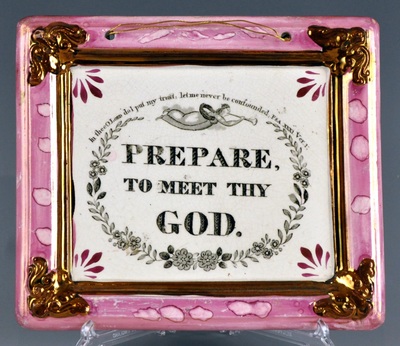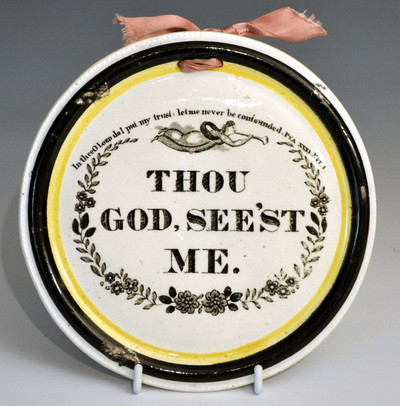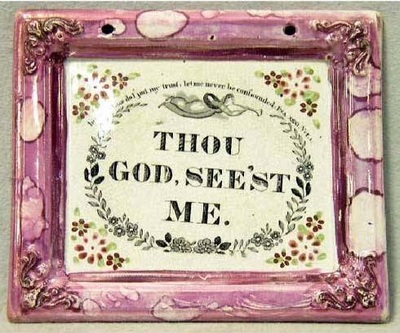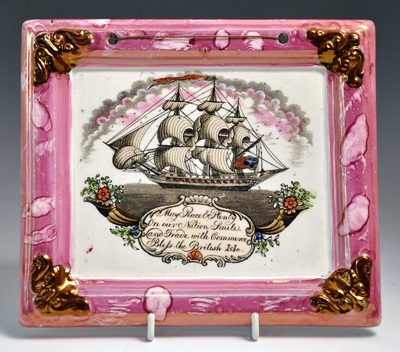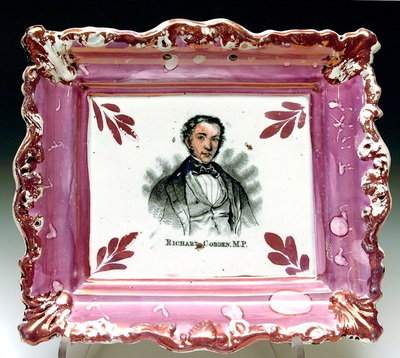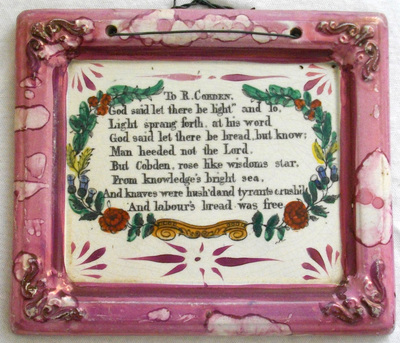|
7/31/2014 0 Comments The group 2 transfersIn my June 14 post, I looked at transfers I'd attributed to Scott's, and divided them into two groups. The group 1 transfers were straightforward enough, because they were traceable back to known Scott wares from the 1830s and 40s. The group 2 transfers' only link with Scott's was that they appeared on the brown-bordered plaques from the 1860s. However, I've since reattributed the brown-bordered plaques to Moore's. So that leaves us with an orphaned group of plaques with group 2 transfers from c1835-1860, the period before they likely arrived at Moore's. To recap, here are the transfers. Firstly the religious verses. The plate 2 Prepare transfer appears on a variety of plaque forms. The first below is attributed to Newbottle, the rest are currently homeless. The plate 3 Prepare transfer also appears to have started life at Newbottle High Pottery, and is found on a similar limited group of plaque forms... Likewise, the plate 3 Thou God transfer... ...and the plate 3 Praise Ye transfer. So if the transfers above started life at Newbottle in the 1830s and ended at Moore's in the 1860s, the strongest contenders to have made the (as yet unattributed) pink-lustre plaques above are Newbottle and Moore's. The argument for Newbottle... The black and yellow Praise Ye plaque was presented to the V&A in 1905 by a descendant of the owners of Newbottle High Pottery, along with a variety of other items. Some have questioned the breadth of objects donated, but archaeological digs of the High Pottery site have since confirmed the provenance of the most contentious items. The fact that Newbottle had two Prepare transfer plates suggests it was making plaques in considerable quantities. The argument against Newbottle... Very little is known about the lustre items Newbottle produced, as they don't appear to have marked anything (all the plaques above are unmarked). The argument for Moore's... Most of the 'group 2' transfers appear on brown-bordered plaques now attributed to Moore's. The argument against Moore's... We have a very clear idea of what Moore's was doing in the 1840-50s, and there's no evidence they used any of the plaque forms above, which never appear with Moore transfers. Conversely, the group 2 transfers don't appear on Moore plaque forms until c1860. Furthermore, there's no evidence of Moore's decorating plaques with hand-painted flowers or green (or blue) corners. And, the Prepare plate 3 above doesn't appear on brown-bordered plaques, so apparently never made it to Moore's. So it's looking like a one-horse race. If it were just the plaques above, we might say why not? And allow the new attribution to pass with little more thought. But attributing the group 2 transfers to Newbottle opens the doors for a an array of other plaques, which, until now, had no links with that pottery. The non-religious group 2 transfers are set out below. The May Peace and Plenty transfer appears on c1845-55 plaques of similar forms to those above, some of those with green or blue corners. The Mariners' Arms and Mariners' Compass transfers also appear on these plaque forms, and another (shown third below), which at first glance looks like a Dixon plaque, but is more heavily potted. A transfer of Richard Cobden appears on the small rectangular group 2 form (first below). It also appears on rectangular plaques, larger than those with brown borders attributed to Moore. It's likely these were made c1846, when the Corn Laws were repealed. A verse dedicated to R. Cobden also appears on the small rectangular plaques, and plaques with blue corners. A verse titled The Farmer sometimes pairs with the R. Cobden verse, and appears on plaques with blue corners and plaques decorated with flowers like those above. And finally, a view of the Cast Iron Bridge Over the River Wear also appears on the group 2 plaque forms. So that makes a hermetic group of 11 transfers and at least 7 plaque moulds, that don't precisely match anything produced by the larger Sunderland potteries - Dixon's, Scott's or Moore's - until c1860 when the transfers appear on the Moore-attributed brown-bordered plaques. All this is consistent with the transfer plates and moulds being at a self-contained location - a smaller pottery producing lustre items. And we have a credible Newbottle provenance, for the religious plaques at least.
More research needs to be done, but the only realistic attribution for these plaques, with the information currently available, is Newbottle High Pottery.
0 Comments
Leave a Reply. |
AuthorStephen Smith lives in London, and is always happy to hear from other collectors. If you have an interesting collection of plaques, and are based in the UK, he will photograph them for you. Free advice given regarding selling and dispersal of a collection, or to those wishing to start one. Just get in touch... Archives
February 2022
AcknowledgementsThis website is indebted to collectors, dealers and enthusiasts who have shared their knowledge or photos. In particular: Ian Holmes, Stephen Duckworth, Dick Henrywood, Norman Lowe, Keith Lovell, Donald H Ryan, Harold Crowder, Jack and Joyce Cockerill, Myrna Schkolne, Elinor Penna, Ian Sharp, Shauna Gregg at the Sunderland Museum, Keith Bell, Martyn Edgell, and Liz Denton.
|


